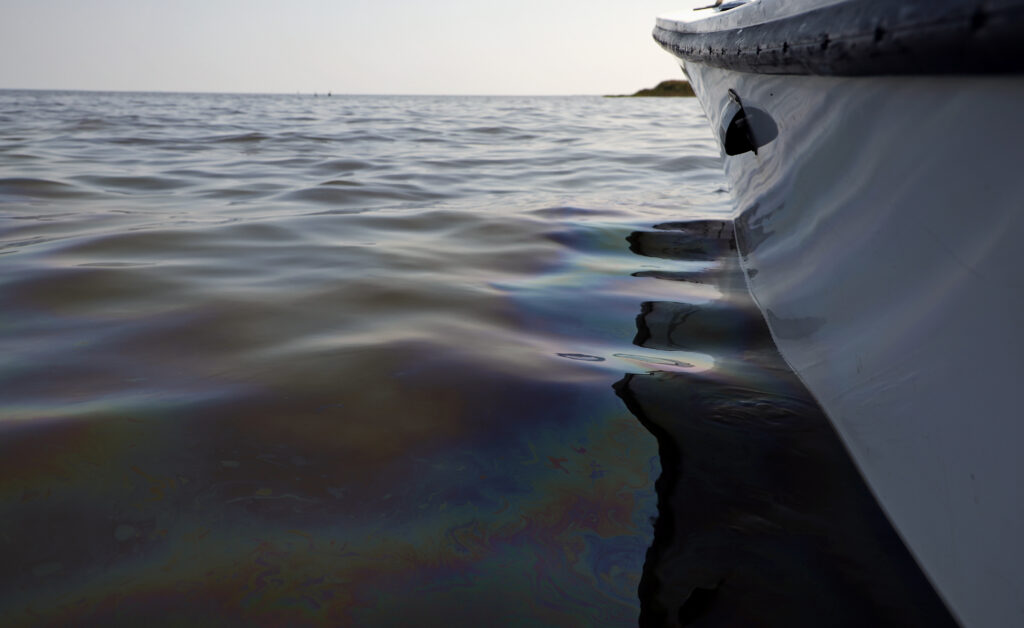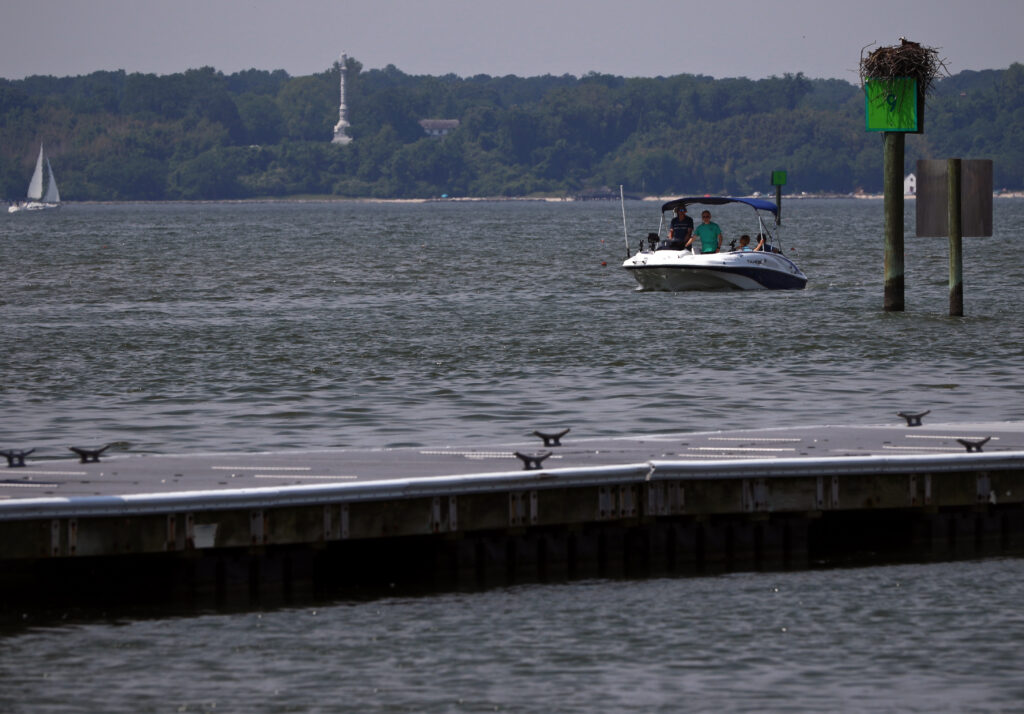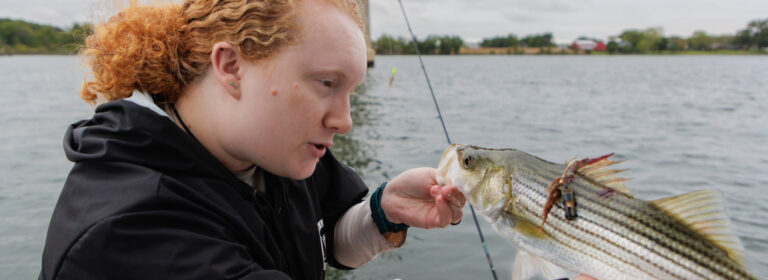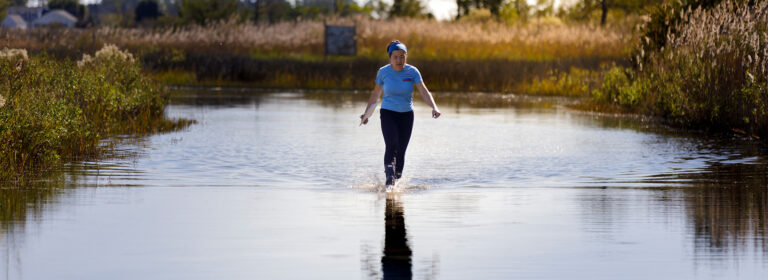Clean Marina Program keeps boat fuel “burps” out of the Bay
Most people would flinch if they spilled gas at the pump every time they fueled up their car. But for boaters fueling up at marinas, a small oversplash as their tank fills up isn’t that uncommon.
These small spills happen when air bubbles escape as the tank fills. On a car, the fuel tank opens sideways, so air can escape from the tank at the same time as the gas flows into the tank. The fuel tank openings on most boats open upwards, so fuel rushing down can create airlocks in the system. Vents in the boat’s gas tank help relieve some of the pressure, but air bubbles can still form, and the only way out is up. As the air escapes, it pushes small amounts of fuel back out of the fuel tank and onto the boat — or into the water.
To prevent these small fuel spills at marina pumps, the Marine Advisory Program at the Virginia Institute of Marine Science is distributing Clean Way Fuel Fill Kits to each of the 73 certified Clean Marinas in Virginia. The kit contains an adapter that fits onto the gas nozzle and has a funnel-like maze for fuel to splash into as air bubbles escape. That fuel then filters back into the tank, rather than spilling into the water or on the boat.
“It keeps fuel completely out of the water, it eliminates the need for bilge pads or rags and keeps that stuff out of the landfill, and it keeps peoples’ boats cleaner,” said Marine Education Specialist Celia Cackowski, who is distributing the kits to marinas.
Each “burp” can be a few tablespoons of fuel, and these relatively small spills add up, especially during the summer weekends. Morgan Waters, general manager at York River Yacht Haven, estimates that the marina can sell as many as 3,000-4,000 gallons of gas over Memorial Day weekend, as dozens of boaters fuel up at the marina for a weekend on the water.
“Our pumps are all self-service, so if someone’s filling up their vessel, they have to fill it up themselves,” Waters said. “An invention like this is definitely helpful for someone newer to boating. It’s all ready for them, so they can just put the pump in and fill up.”

“Our pumps are all self-service, so if someone’s filling up their vessel, they have to fill it up themselves,” Waters said. “An invention like this is definitely helpful for someone newer to boating.”
Each “burp” can be a few tablespoons of fuel, and these relatively small spills add up, especially during summer weekends.

During the hot summer months, a boat’s fuel tank will naturally expand and shrink with changes in temperature. This adds to the potential for airlocks in the system and backsplash that happens during refueling.
The fuel fill devices can be especially helpful for new boaters, who may not expect the splash of fuel out of the tank or know how to contain a spill. It was a rookie mistake at the pump that first prompted Garry Fox to create the Clean Way Fuel Fill device. After he purchased a boat, he spilled fuel the first time he went to fill the boat’s tank.
“The very first time I fueled it, the fuel backed up, got onto the boat’s carpet, and in the water,” Fox said. “I came home with my new boat, and I spent the next few days dreading refueling. I got on the internet and looked for something that would capture the burp and not let it happen.”
He couldn’t find any alternatives to the absorbent pads or rags normally used to soak up a spill, so the retired architect designed the Fuel Fill Kit to trap the “burped” fuel and drain it back into the tank. Although some of the fuel backsplash can be avoided by refueling very slowly, the fuel fill devices allow people to refuel at full speed, saving time at the pump.
“When you pull up to a marina, it’s not like pulling into a gas station with five islands and 15 pumps,” Fox said. “A marina has maybe 4-6 pumps and on a busy day, there might be 10 boats waiting 30 yards away, jockeying around for the next opening.”
Currently, when fuel leaks into the water, marinas use absorbent pads that soak up fuel, or spray a chemical that sinks larger spills down to the bottom of the water. The new device keeps fuel out of the water, and it also reduces the amount of fuel-soaked absorbent pads and rags that would otherwise be destined for the landfill. This helps the certified Clean Marinas meet the water quality standards from the Department of Environmental Quality, and serves as another way to minimize the marina’s environmental impact.
“This prevents spills at the source, instead of having to mitigate spills,” Cackowski said.
Takeaways:
Air bubbles trapped in a boat’s gas tank during refueling can bubble back up, creating a “burp” of fuel that can spill into the water.
The Clean Way Fuel Fill Kit prevents gas spillage. The device attaches to the gas nozzle and directs the “burp” of gas into a funnel-like maze, where it can flow back down into the gas tank instead of spilling.
The VIMS Marine Advisory Program is distributing the devices to more than 70 marinas participating in the Virginia Clean Marina program.
Photos by Aileen Devlin | Virginia Sea Grant
Story by Madeleine Jepsen | Virginia Sea Grant
Published Aug. 10, 2022.
“This prevents spills at the source, instead of having to mitigate spills,” Cackowski said.





